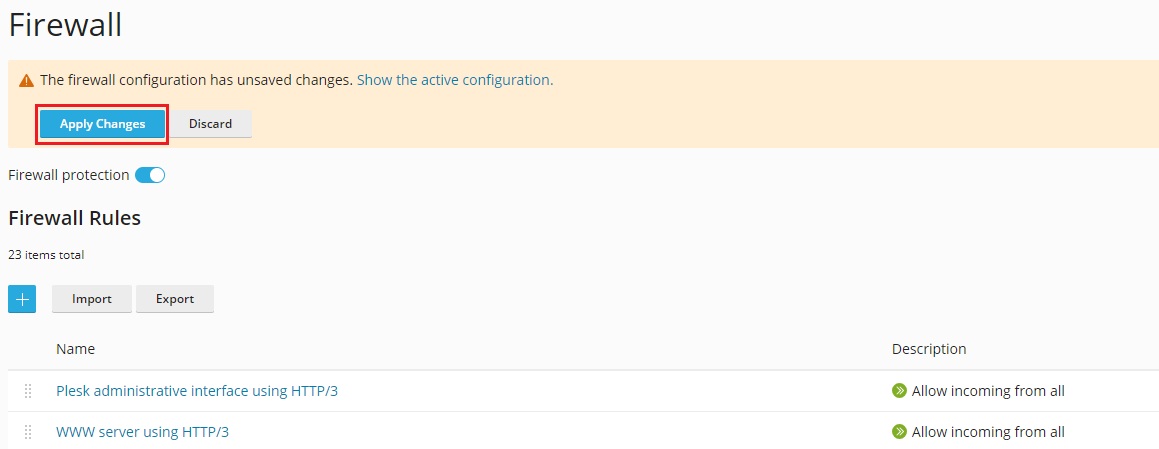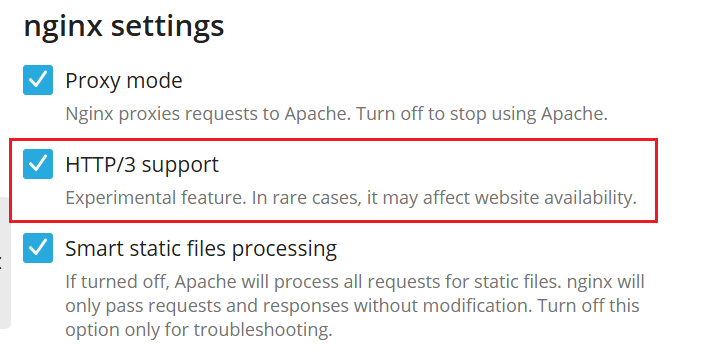(Plesk para Linux) Soporte de HTTP/3 en Plesk
HTTP/3 <https://datatracker.ietf.org/doc/html/rfc9114>`__ es la tercera versión principal de HTTP (Hypertext Transfer Protocol) utilizado para intercambiar información en la World Wide Web. HTTP/3 es la última versión de HTTP y un avance significativo respecto a HTTP/2, introducido en 2015.
En comparación con las versiones HTTP anteriores, HTTP/3 presenta las siguientes ventajas:
- Las conexiones HTTP/3 son más rápidas, seguras y fiables. Los sitios web que utilizan HTTP/3 se cargan más rápido y con una latencia mínima.
- Los sitios web visitados desde dispositivos móviles se cargan más rápido. HTTP/3 funciona con QUIC, un nuevo protocolo de transporte. Ha sido diseñado para funcionar mejor con las redes móviles y los cambios constantes de una red a otra.
- HTTP/3 es una tecnología de vanguardia y un nuevo estándar. Constituye una ventaja de marketing para los sitios web que la adopten.
Incidencias conocidas, limitaciones y notas técnicas
-
El soporte de HTTP/3 se basa en el servidor web nginx. Esto significa que HTTP/3 funciona cuando los sitios web son servidos únicamente por nginx o la combinación de nginx y Apache.
Prudencia: El soporte de HTTP/3 es una función experimental tanto en nginx como en Plesk. Actívelo a su discreción porque puede tener efectos secundarios negativos (por ejemplo, sus sitios web pueden quedar offline).
-
HTTP/3 no funciona cuando el componente «Nginx web server and reverse proxy server» no está instalado en Plesk. En este caso, los sitios web son servidos únicamente por Apache, que no soporta HTTP/3.
-
Plesk en CentOS 7 y Ubuntu 18 no soportan HTTP/3. Para activar HTTP/3, realice un dist-upgrade de su SO o migre a uno moderno usando Plesk Migrator.
-
Al activar HTTP/3 para un sitio web sin el modo proxy nginx activado, se añadirá automáticamente la directiva
fastcgi_param HTTP_HOST $host;al archivo de configuración nginx del sitio web. Este cambio se introdujo para evitar interrupciones o problemas de funcionalidad que pueden producirse en ciertos casos cuando HTTP/3 está activado, pero el modo proxy nginx está desactivado.
Activación de HTTP/3 para el servidor Plesk
Plesk soporta HTTP/3 para sitios web alojados que usan nginx o nginx y Apache. HTTP/3 no está activado de forma predeterminada. Debe activarlo manualmente.
Para activar HTTP/3 para el servidor Plesk:
-
Inicie sesión en el servidor mediante Plesk y ejecute el siguiente comando:
plesk bin http3_pref --enable -nginx
El comando activa HTTP/3 para sitios web alojados procesados por nginx o nginx y Apache.
Nota: La activación de HTTP/3 activa automáticamente TLS 1.3.
-
Vaya al firewall que utiliza y añada reglas de firewall que permitan conexiones entrantes al puerto UDP 443.
Nota: HTTP/3 funciona con QUIC, un nuevo protocolo de transporte. Significa que, a diferencia de HTTP/2, HTTP/3 utiliza UDP (User Diagram Protocol), no TCP (Transmission Control Protocol).
Si usa el firewall de Plesk, este le ofrecerá automáticamente los cambios en la configuración de su firewall solicitados por el comando CLI del paso anterior. Para aceptar estos cambios y activar las reglas de firewall necesarias para HTTP/3, haga clic en Aplicar cambios.
-
Compruebe si se ha activado HTTP/3 para los sitios web alojados. Para ello, le recomendamos que utilice un servicio de terceros; por ejemplo, HTTP/3 Check. También puede comprobar el soporte de HTTP/3 en la consola de desarrollador de su navegador (en la pestaña «Red», consulte el protocolo utilizado para transferir datos).
Nota: La activación de HTTP/3 para el servidor Plesk también lo activa automáticamente para todos los sitios web alojados.
Activación/Desactivación de HTTP/3 para un sitio web
-
Vaya a Sitios web y dominios > tarjeta del dominio > pestaña «Hosting y DNS» > Apache y nginx.
-
Una vez activado HTTP/3 a nivel de servidor, todos los sitios web alojados lo soportan de forma predeterminada. Para desactivar HTTP/3 en un sitio web, deseleccione la casilla «Soporte de HTTP/3» y haga clic en Aceptar. Para volver a activar HTTP/3 en un sitio web, seleccione la casilla «Soporte de HTTP/3» y haga clic en Aceptar.
Desactivación de la gestión HTTP/3 para los sitios web
De forma predeterminada, los clientes y revendedores pueden activar y desactivar HTTP/3 para sitios web individuales. Como administrador de Plesk, es posible que desee conservar la configuración HTTP/3 existente e impedir que sus clientes y revendedores la modifiquen.
Para desactivar la gestión HTTP/3 para los sitios web:
-
Abra el archivo panel.ini para proceder con su edición. Este archivo se encuentra en``/usr/local/psa/admin/conf/panel.ini``.
También puede editar el archivo en la interfaz de Plesk usando la extensión Panel.ini Editor.
-
Añada las siguientes líneas al archivo
panel.iniy guárdelo:[domainManagement] features.nginxHttp3PerDomain = false
Ha desactivado la gestión HTTP/3 para los sitios web, y la casilla de verificación «Soporte de HTTP/3» ya no se muestra en la configuración de Apache y nginx de los sitios web.
Nota: Para ver las opciones y comandos CLI relacionados con HTTP/3, ejecute plesk bin http3_pref --help.

